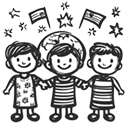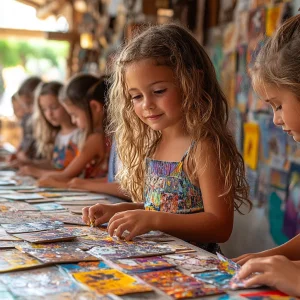Activity
Similar Activities
Sensory Exploration Journey: Household Items Adventure
Children’s Age: 0 month – 6 years
Activity Duration: 10 minutes
Let's explore different textures and shapes using household items! Find a big container and items like a wooden spoon, silk scarf, plastic cup, sponge, and cotton ball. Sit togethe…
Activity Duration: 10 minutes
Cultural Photo Exploration: World Wonders Journey
Children’s Age: 6–10 years
Activity Duration: 20 minutes
Embark on the "Cultural Photo Exploration" activity to boost children's play skills, cultural awareness, and academic development through an outdoor photography journey. Choose a d…
Activity Duration: 20 minutes
Whispers of the Sports Storytelling Relay
Children’s Age: 8–12 years
Activity Duration: 35 – 45 minutes
Engage children aged 8 to 12 in the "Sports Storytelling Relay" activity, a fun game promoting language development, cognitive skills, and empathy. Set up a safe relay course with …
Activity Duration: 35 – 45 minutes
Enchanted Puzzle Quest: Teamwork Puzzle Challenge
Children’s Age: 7–9 years
Activity Duration: 40 – 45 minutes
The "Teamwork Puzzle Challenge" activity is designed to boost moral development, teamwork, problem-solving, and communication skills in children. You'll need age-appropriate puzzle…
Activity Duration: 40 – 45 minutes
Cultural Collage Celebration: Embracing Diversity Through Art
Children’s Age: 6–10 years
Activity Duration: 15 minutes
Explore and celebrate cultural diversity with the "Cultural Collage Celebration" activity designed for children. Enhance academic skills by creating a collaborative cultural collag…
Activity Duration: 15 minutes
Animal Feast Adventure: A Whimsical Feeding Frenzy
Children’s Age: 5–8 years
Activity Duration: 10 – 25 minutes
An interactive activity where children feed toy animals with pretend food, promoting communication skills and adaptive development.
Activity Duration: 10 – 25 minutes
Enchanted Melodies: The Musician Money Mystery Game
Children’s Age: 9–12 years
Activity Duration: 10 minutes
An engaging activity where children learn about probability and famous musicians while earning money for clues in a mystery game.
Activity Duration: 10 minutes
Bridge Builders: Eco Teamwork and Critical Thinking
Children’s Age: 8–9 years
Activity Duration: 10 – 25 minutes
An eco-conscious activity where children build bridges using popsicle sticks and tape to support toy cars, promoting teamwork and environmental awareness.
Activity Duration: 10 – 25 minutes
Magical Playdough Making and Sensory Adventure
Children’s Age: 0 month – 6 years
Activity Duration: 10 minutes
Let's make homemade playdough together! It's a fun sensory activity that helps children explore different textures and colors while developing their muscles and creativity. Gather …
Activity Duration: 10 minutes
Holiday Parade: Musical Social Skills Celebration
Children’s Age: 2–3 years
Activity Duration: 15 minutes
Get ready for the Holiday Music Parade! This fun activity is perfect for 2 to 3-year-old kids to enjoy music, march in a parade, and have a blast with holiday props. You'll need mu…
Activity Duration: 15 minutes


























